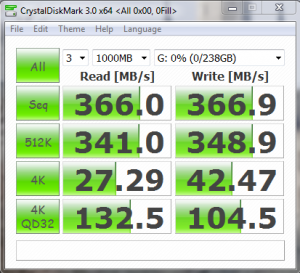CRYSTAL DISK BENCHMARK VER. 3.0 X64
Crystal Disk Benchmark is used to measure read and write performance through sampling of raw (0/1 Fill/compressible) or random data which is, for the most part, incompressible. Many new SandForce Driven SSD owners who cant wait to test the performance of their SSD often grab this program and run a quick test, not realizing that they are testing with incompressible data rather than compressible data used in testing by manufacturers. We have provided compressible (oFill) results on the left with incompressible (random data) results on the right.

 Performance in Crystal DiskMark is pretty much as expected for the sequential transfer speeds but we might have like to see low 4k random write performance a bit higher. Once again, this appears to be a limitation of the ASMedia controller.
Performance in Crystal DiskMark is pretty much as expected for the sequential transfer speeds but we might have like to see low 4k random write performance a bit higher. Once again, this appears to be a limitation of the ASMedia controller.
Up until recently, AS SSD was the only benchmark created specifically for SSD testing and it uses incompressible data. AS SSD, for the most part, gives us the worst case scenario in SSD transfer speeds because of its use of incompressible data and many enthusiasts like to AS SSD for their needs. Transfer speeds are displayed on the left with IOPS results on the right.

 AS SSD confirms what we say in Crystal DiskMark and takes it a step further by givin an idea of what IOPS performance we might see. As well, the AS SSD Copy Bench results are very encouraging and actually surpass results we have seen in some typical SSDs.
AS SSD confirms what we say in Crystal DiskMark and takes it a step further by givin an idea of what IOPS performance we might see. As well, the AS SSD Copy Bench results are very encouraging and actually surpass results we have seen in some typical SSDs.
ANVIL STORAGE UTILITIES PROFESSIONAL (BETA)
You may not see this for long (and its definitely not common) but you get a freebee simply for reading! Over the last little while, we have been assisting with beta testing new benchmark software called Anvil Storage Utilities which is an absolutely amazing SSD benchmarking utility. Not only does it have a preset SSD benchmark, but also, it has included such things as endurance testing and threaded I/O read, write and mixed tests, all of which are very simple to understand and utilize in our benchmark testing.
Once again, Anvil confirms much of what we have seen and provides us with a clear picture of the AccelsiorM capabilities. Although it is a SATA 3 capable device, it does restrict your SSD from performing at full power, however, we knew that. In typical use, the difference is not noticeable and, in fact, right now our main system is running off of the AccelsiorM/XPG combination as its boot drive.
 The SSD Review The Worlds Dedicated SSD Education and Review Resource |
The SSD Review The Worlds Dedicated SSD Education and Review Resource | 
Can you RAID two of these cards on an ICH10 chipset?
The Accelsior is raidable on a mac pro at least..
very interesting solution but it would be nice to see this with 2 or more msata
+1 Inovation
I would love to see a “Professional” or “Enthusiast” version that utilizes a PCIe x4 or even x8 slot, and has space for 2-4 mSATA SSD’s and uses an actual LSI hardware RAID chip and a nice and round 1024MB of DDR3 cache to RAID0/1/5/10 the drives, and maybe even a small integrated Battery Backup for use during power failures (enough to keep the drives holding data for 48-72hrs shouldn’t be expensive nor take up hardly any room).
Can you imagine a 4x256GB RAID-0 array capable of 2GB/s reads/writes, and the entire thing is smaller than a sound card??? OH WHAT I WOULD GIVE!
BEWARE! Installing the AccelsiorM with a 256GB mSATA card in my Mac Pro has screwed up native boot into the separate Mac Bootcamp partition (Bay2 Drive). The screen gets as far as “Using PCIE Gen 2” but no further.
The card is fine running MACOS (boot time under 12 seconds) but won’t boot via the Option key into Win7 on start up. Anyone got any suggestions?